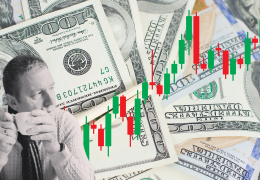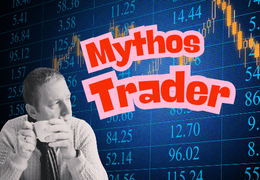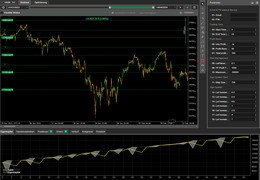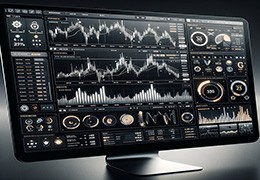Between reality and illusion If you want to know what trading really means—beyond luxury cars, piles of cash, and...
Understanding market indices
Understanding market indices
Market indices play a crucial role not only for day traders, but also for long-term Investors. They provide important clues and provide detailed Information about the general development of the market and the prevailing mood in various economic sectors. An index is a composite metric that tracks a carefully selected group of stocks This selection is usually representative of certain sectors or even the entire market.
A market index offers thus a comprehensive picture of the performance of the market or a specific It can determine the average price of the shares contained in it or their total market capitalization. A good understanding of Market indices and their composition enables investors and traders to to understand and interpret the overall sentiment of the market. You can Use information to compare the performance of certain stocks or sectors with the broader market or to identify trends and to develop trading strategies.
An example of a well-known market index is the Dow Jones Industrial Average (DJIA), which includes 30 major US companies and is often used as an indicator for the entire US economy. Other well-known indices are the S&P 500, the 500 of the largest publicly traded US companies, and the Nasdaq Composite, which includes all stocks listed on the Nasdaq stock exchange.
It is important to note that a Index itself cannot be bought or sold. Instead, investors can invest in index funds or exchange-traded funds (ETFs) that aim to replicate the performance of a particular index.
Overview of important Market indices:
1. Dow Jones Industrial Average (DJIA):
The Dow Jones Industrial Average (DJIA) is more than just a number in the financial news; it is a historical barometer of the American economy. Since its founding in Since 1896, the DJIA has become one of the leading indicators of health the US economy and global financial markets. Consisting of 30 leading American companies, the DJIA reflects the market sentiment and reflects the economic dynamism of a wide range of industries, from From finance to technology to consumer goods.
The selection of the DJIA represented companies follows strict criteria, whereby only companies with a solid reputation, sustainable profitability and significant market capitalization. This process ensures that the index provides an accurate picture of economic strength and innovation potential of the US economy.
The importance of the DJIA for day traders and long-term investors cannot be overestimated As one of the most closely followed indices in the world, it often serves as Guide to assessing market direction and general economic climate. Fluctuations in the DJIA can inform market participants about changes in the Inform company performance and potential economic turning points, which is crucial when planning trading and investment strategies meaning is.
In addition to his In addition to its role as an economic indicator, the DJIA also serves as a benchmark for Investment funds and portfolios that deliver performance in line with the leading Companies in the US economy are striving for. By observing the movements and trends within the DJIA, investors and analysts can gain insights into the broader market conditions and make more informed decisions.
In a world where financial markets are increasingly interconnected and influenced by global events influenced, the Dow Jones Industrial Average remains a central Tool for anyone who wants to measure the pulse of the US economy and beyond His continued relevance and authority make him a indispensable tool for the financial community.
2. S&P500 Index:
The S&P 500 Index is considered one of the best reflections of the US economy and is known for its comprehensive representation of the American stock market. With 500 of the leading companies from the most important industries of the US economic sector The S&P 500 provides a broad overview of the performance of the American Economy. Unlike the Dow Jones Industrial Average, which only has 30 companies, the S&P 500 offers a deeper and broader perspective, making it a preferred index for many professional investors and analysts.
The composition of the S&P 500 is regularly reviewed to ensure that the index reflects the changing landscape of the US economy. Companies in the S&P 500 are selected based on their market capitalization, whereby Liquidity, industry affiliation and geographical diversification This rigorous selection ensures that the index is a accurate picture of economic performance across a broad spectrum of industries across the board.
For day traders and long-term investors alike, the S&P 500 is an essential Tool for assessing the health of the US economy. The Performance of the S&P 500 often serves as a benchmark for the general Market level and as a benchmark for the performance of individual Stock portfolios. A rising trend in the S&P 500 usually indicates indicates a robust economic situation, while a decline indicates potential can indicate difficulties.
In addition, many Investment funds and ETFs use the S&P 500 as the basis for their Investment strategies, which shows the importance of this index in the global financial world The S&P 500 is not only a barometer for the US economy, but also serves as an important indicator for global Investors seeking insights into the American markets and beyond seek.
The broad recognition and the trust that the S&P 500 enjoys make it an indispensable tool for the financial community worldwide. Its ability to capture the dynamics of US economy and to serve as a guide for investment decisions. confirms its role as one of the most important financial indices in the world.
3. NASDAQ Composite Index:
The NASDAQ Composite Index is a broad-based stock index that includes over 3,000 NASDAQ stocks It is considered an important indicator for the Performance of companies, especially in the technology sector, as it high concentration of technology stocks. In contrast to traditional indices such as the Dow Jones Industrial Average or the S&P 500, which represent a mix of different industries, the NASDAQ Composite provides a deeper insight into the world of technology and innovation.
The composition of the NASDAQ Composite is broadly diversified and includes the heavyweights of the technology industry, smaller start-ups and companies from the fields Biotechnology, healthcare, industrial, consumer goods and many more. These Diversity makes the NASDAQ Composite a valuable barometer for the Health and trends within the technology sector as well as for the broader stock market.
Due to its strong Focusing on technology companies, the NASDAQ Composite reacts particularly sensitive to changes in technological progress, regulatory Developments in the technology sector and changes in consumer habits of the digital economy. This makes it an important index for Investors who want to stay at the forefront of technological innovation.
The NASDAQ Composite has in recent decades due to the increasing importance of technology has gained importance in the global economy. The rapid development of Technology industry and the central role of technology companies in economic life have made this index a key indicator of the state and future prospects of the global economy.
For day traders and long-term investors alike, the NASDAQ Composite offers valuable Insights into the dynamics of the technology market. The performance of the index can provide clues to the general market direction and help to identify potential investment opportunities. Since the Technology sector continues to play a leading role in the global economy plays, the NASDAQ Composite remains an indispensable tool for all those who want to feel the pulse of innovation and technological progress.
4. FTSE100 Index:
The FTSE 100 Index, often known as "Footsie", is the leading stock market index which covers the performance of the 100 largest companies that listed on the London Stock Exchange (LSE). As a barometer for the The FTSE 100 offers a comprehensive insight into the health and trends of the UK stock market.
The FTSE 100 listed companies represent a wide range of industries, including financial services, oil and gas, pharmaceuticals, consumer goods and many more. This diversity makes the index a valuable indicator for the general market sentiment and offers investors and analysts a broad Perspective on the British and global economy.
As one of the most closely followed stock indices worldwide, the FTSE 100 attracts a significant international attention and serves as the basis for a Variety of financial products, including exchange traded funds (ETFs), Futures and options. The global relevance of the index reflects the international nature of the companies listed in it, many of them are global actors with significant operations and influence over the beyond the borders of Great Britain.
The performance of the FTSE 100 is closely linked to the state of the global economy, especially due to the strong export orientation of many of its component companies. Changes in global economic performance, currency fluctuations, political Events and other external factors can have a significant impact on the have an index.
For investors and traders The FTSE 100 offers valuable insights into economic performance Great Britain and serves as an essential tool for investment decisions, both for those who focus on the British market and for global investors seeking a broader range of investment opportunities Observing the movements of the FTSE 100 can provide clues to the market sentiment and help determine the direction of future market movements to predict.
In summary, the FTSE 100 is a crucial index for anyone who follows the British stock market and the wider economic trends in the UK and Its role as a leading indicator of economic performance makes it an indispensable tool for a wide range of market participants.
5. DAX Index:
The DAX Index, officially known as the German Stock Index, is a key performance indicator for the German stock market. It includes the 30 largest and most profitable Companies listed on the Frankfurt Stock Exchange. As a barometer of the German economy, the DAX provides insight into the state and Prospects of the largest European economy.
The DAX-listed Companies represent a wide range of industries, including Automotive, technology, pharmaceuticals, energy and financial services. These Diversity reflects the complex and robust nature of the German economy, makes the index a valuable indicator for investors worldwide and contributes help to provide a comprehensive picture of the entire market.
As one of the most followed stock indices in Europe, the DAX plays a central role for global investors looking for investment opportunities in Germany. The The performance of the DAX is not only important for investors who invest directly in the companies included in the index, but also for those who invest in German or European ETFs, mutual funds and other financial products invested in companies that use the DAX as a benchmark.
The DAX is also for its volatility, which is caused by economic changes in Germany, the Eurozone and global markets. Political Events, changes in economic policy, currency fluctuations and other external factors can lead to significant movements in the index. For The DAX offers day traders and long-term investors alike both challenges and opportunities.
The observation of the DAX performance can provide valuable insights into the health of the German economy and provide indications of the direction in which the European and global economy. Investors use the DAX often used as a tool to assess the attractiveness of the German market in Comparison to other global investment opportunities.
In summary, the DAX Index is an indispensable tool for anyone who wants a deep understanding for the dynamics of the German stock market and its impact on the global economy. Its significance extends far beyond beyond Germany’s borders and makes it a central focus for international investors looking for indicators of economic health and look for investment opportunities in Europe.
6. Nikkei225 Index:
The Nikkei 225 Index is a leading stock market index for the Tokyo Stock Exchange (TSE) in Japan and represents the performance of 225 selected blue-chip companies of the country. As one of the most prominent stock indices in Asia, the Nikkei 225 valuable insights into the Japanese economy and is an important Indicator for investors worldwide who are interested in the Asian market interested in.
The Nikkei 225 The companies included reflect a wide range of industries, including technology, automotive, consumer goods and financials, making the index a comprehensive barometer of Japan’s economic performance The index is capitalization-weighted, which means that companies with higher market capitalization has a greater influence on the movement of the Indexes have.
The Nikkei 225 is not not only important for local investors, but also for international Investors who follow the Asian markets. The performance of the Nikkei provides insight into economic trends in Japan, one of the largest and most advanced markets in the world, and provides guidance for the global Economic dynamism, especially in Asia.
Investors worldwide use the Nikkei 225 as a benchmark to measure the performance of their investments in Japanese stocks or Japan-related investment funds and ETFs. The Volatility of the Nikkei 225 can be influenced by internal factors such as changes in the Japanese Economic policy, corporate results and macroeconomic data but also by external events such as global market trends and geopolitical developments.
The Nikkei 225 offers an important perspective for assessing the health of the Japanese economy and its sectors. Observing its movements can Help investors identify opportunities and risks in one of the most dynamic markets in Asia. Its role as a key indicator for the Japanese stock market makes it an indispensable tool for anyone interested in the Asian economy and global financial markets is interested.
7. Hang Seng Index:
The Hang Seng Index is the main stock index of the Hong Kong Stock Exchange and includes the 50 largest and most liquid companies. It is considered the primary indicator of the general Market performance in Hong Kong and provides a comprehensive overview of the financial health and economic dynamism of the region. This index is particularly relevant for investors interested in the Asian market interest, as Hong Kong plays a central role as an international financial center and gateway to China's enormous market. The Hang Seng reflects not only the performance of local companies, but also that of multinational companies listed in Hong Kong and across Asia do business.
The composition of the Hang Seng Index spans various sectors such as finance, Real estate, industry and utilities, making it a diverse and balanced barometer of the economy. The performance of the Hang Seng is of local and global economic factors, political events and Market sentiment, making it an important indicator for the Assessing market trends and investor sentiment in Asia.
Investors worldwide use the Hang Seng Index to measure the performance of investments in the region and serve as a benchmark for Asian or Chinese-related Mutual funds and exchange-traded funds (ETFs). The movements of the Hang Seng provide valuable insights into Hong Kong’s economic prospects and China, making it an indispensable tool for analysis and Strategy development in the Asian financial market.
As one of the most observed indices in Asia, the Hang Seng reflects the dynamics and Challenges of the Hong Kong and Chinese markets. It offers a essential resource for investors seeking comprehensive insights and Understanding the developments in this fast-moving and increasingly integrated economic region.
8. CAC 40 Index:
The **CAC 40 Index** is a major French stock market index that includes the 40 largest and most liquid companies listed on Euronext Paris, formerly known as Paris Stock Exchange. The name CAC stands for "Cotation Assistée en Continu", which means continuous quoted stock exchange listing, and illustrates the method of continuously updating the index values during of the trading day.
The CAC 40 is a Capitalization-weighted index, which means that companies with higher Market capitalization has a greater influence on the movement of the index This index is an important indicator of general health of the French economy and provides a window into the performance of the French stock market. It covers a wide range of sectors, from Financial services and industrial goods, healthcare and luxury goods, making it a comprehensive reflection of the French Economy makes.
The CAC 40 plays a central role for investors interested in European markets, by providing insights into France’s leading companies. He will not only from domestic but also from international investors monitored to assess market sentiment in Europe and as a benchmark for investment decisions in French equities.
The performance of the CAC 40 is influenced by a variety of factors, including global economic developments, interest rates, exchange rates and political Events in Europe. Due to its broad coverage of the French The CAC 40 is often used by fund managers and institutional investors Investors use it to compare the performance of their portfolios and to develop investment strategies.
For investors who seek deeper understanding of the French market and invest in leading If you want to invest in French companies, the CAC 40 offers a valuable resource. It provides important insights into the economic dynamics and Market trends in France and is an essential tool for evaluating and analysis of investment opportunities in one of Europe's largest markets.
9. EURO STOXX 50:
The EURO STOXX 50 is a leading stock index that tracks the performance of the 50 largest and most liquid Blue chip companies in the Eurozone. These companies come from different industries and sectors, making the EURO STOXX 50 a broad diversified index that tracks the economic performance of the countries participating in the monetary union.
Developed by STOXX, a subsidiary of Deutsche Börse Group, the index serves as Barometer for general market sentiment and economic health of the Eurozone. It is not only an important market for investors and fund managers indicator, but also for policy makers and Economists who study the developments of the European economy observe.
The EURO STOXX 50 is for its stability and the quality of the companies it contains, which include some of the world's leading and most heavily capitalized companies. The index offers an efficient way for investors to to invest in the Eurozone without having to analyse individual stocks. He is the basis for a variety of financial products, including Exchange Traded Funds (ETFs), futures, options and structured products.
A special feature of the EURO STOXX 50 is its ability to provide investors with insights into the overall performance of the Eurozone markets without affecting performance by companies from non-Eurozone countries. This makes it a valuable Tool for investors who want to invest specifically in the Eurozone and looking for a high degree of liquidity and transparency.
Given the economic and political integration within the European Union The EURO STOXX 50 plays a central role in assessing the strength and Stability of the European economy. Its development is carefully monitored by Market participants and analysts to identify trends that Influence on investment strategies and economic policy decisions in the Eurozone.
Overall, the EURO STOXX 50 is an essential tool for anyone interested in the European It offers a clear and comprehensive presentation of market conditions in the Eurozone and enables investors to to strategically position ourselves in leading European companies.
Importance of Indices for day trading:
Market sentiment and trends:
Market indices such as the Dow Jones Industrial Average, S&P 500, or the NASDAQ Composite, are crucial tools for day traders to understand the general mood of the market and identify overarching trends. These indices provide a Snapshot of market performance and reflect the activities of largest and most actively traded companies.
A rising index indicates a positive market sentiment, where investors are optimistic about on the economic future and corporate profits. In such phases Day traders tend to speculate on a continuation of the uptrend and seek purchase opportunities in accordance with this general market sentiment.
Conversely, a falling index indicates negative market sentiment, possibly triggered by economic uncertainties, political tensions or disappointing In such times, day traders may be more cautious Take a stance and look for sales opportunities or take a defensive sectors.
Indices also serve as Benchmark against which day traders can measure the performance of their trades. A Outperforming the market can be an indicator of a successful trading strategy, while underperforming may be a reason for review and There could be an adjustment of the strategy.
Benchmarking:
Benchmarking is a essential element in the arsenal of a day trader, as it is an objective method offers the opportunity to measure the performance of individual trades or the entire portfolio Market indices such as the Dow Jones Industrial Average, S&P 500, or the NASDAQ Composite play a central role here, because they reflect the general market development and serve as a benchmark for market performance.
A day trader may For example, compare its performance against the S&P 500 to assess whether his trading strategy produces above-average results in comparison with the broader market. Such benchmarking not only helps in determining the relative success of one’s own trading decisions quantify, but also identify areas for potential improvement and Identify strategy adjustments.
In addition, Benchmarking helps traders to better understand the risk of their portfolio. comparing the volatility of their portfolios with that of the selected index Traders can assess whether they are exposed to a higher risk than the market in general. This is especially important in turbulent market phases, in where risk management and strategy adaptation are crucial for preserving capital and maximizing returns.
Benchmarking supports Day traders also assess the efficiency of their trading decisions. By comparing the performance of their trades with a relevant market index compare, they can determine whether the selection of certain stocks or sectors has actually contributed to outperformance of the market. This promotes disciplined action, motivated to continuous training and Fine-tuning trading strategies to continuously improve results in comparison with the market standard.
In summary, the Benchmarking is a critical tool for day traders, not only for performance measurement, but also a deeper understanding of the market mechanisms and their own trading practices. By daytraders Performance of their trades systematically with the movements of relevant indices compare, they can make more informed decisions, their Improve trading strategies and ultimately achieve their goal of successful and achieve profitable trading activity.
Diversification:
Diversification is a fundamental concept in finance that serves to quantify the risk in a Portfolio. For day traders, who often deal with high risk and high Volatility, the use of indices through Index futures and options provide an excellent opportunity for diversification their trading strategies.
Indices such as the S&P 500, the DAX, or the Nikkei 225 represent a cross-section of different sectors and companies, making it an ideal tool for Investors who are looking for broader market exposure without individual stocks analyze and select. By trading index futures and -Options allow day traders to benefit from the movements of the entire market or specific market segments while simultaneously reducing risk across a variety of companies and industries.
Trading with Index futures and options not only allow day traders to bet on rising markets, but also offers mechanisms to profit from falling markets. This is particularly useful in times of economic Uncertainty or market volatility in which traditional investment strategies may not produce the desired results. By using Such derivatives allow traders to hedge their portfolios against losses and while simultaneously benefiting from short-term price movements.
In addition, Index futures and options day traders, with a fraction of the capital that for the direct purchase of shares, a significant market position This leverage effect can increase returns, but also entails an increased risk, which requires a careful risk management strategy.
Diversification through The use of index derivatives is a strategy that not only reduces the risk but also offers flexibility and access to global markets. For Day traders looking for ways to diversify their trading approaches and at the same time to operate effective risk management, indices offer and their associated derivatives are valuable instruments to achieve this. However, it is important that traders understand the mechanisms and risks associated with trading of these instruments in order to make informed and to be able to make strategic decisions.
Strategic Decisions:
The role of Market indices in supporting strategic decisions in day trading cannot be overestimated. Indices such as the S&P 500, the DAX or the Nikkei 225 provide valuable insights into the general market direction and the performance of specific industries. This information is provided by invaluable for day traders who aim to increase their Trading decisions based on solid data and a sound analysis of the market conditions.
Indices act as Barometers for market sentiment and provide insights into economic performance both at national and international level. By following of index movements, traders can see whether investors are confident or are concerned about the economic future. This information can crucial to identify market trends and foresighted to make trading decisions.
In addition, Changes within the index composition Indications of industry trends For example, an increase in technology stocks within a Index may indicate that the technology sector is growing or favored. Day traders who recognize such trends early can benefit from by selecting stocks that are likely to benefit from this dynamic become.
Indices also serve as Benchmark for the performance of individual stocks. By measuring the performance of their selected stocks with that of the corresponding index, traders can evaluate the relative strength of their stocks. This is particularly helpful in determine whether a stock is attractive due to its own characteristics or due to general market movements rises or falls.
Furthermore, Indices offer the opportunity to bring diversification into the trading portfolio, without having to invest in individual stocks. By using Index futures, options or ETFs allow day traders to invest in the entire market or specific sectors. This strategy can help to increase the To diversify risk and reduce portfolio volatility.
The strategic use However, indices require continuous monitoring and analysis. Market conditions change rapidly, and what is a profitable strategy today may be less effective tomorrow. Successful day traders use indices as part of a comprehensive analysis approach that includes technical, fundamental and quantitative analyses to make informed decisions and improve their To maximize chances of success.
Volatility measurement:
The measurement of Volatility through indices such as the VIX, often referred to as the "fear index" is an indispensable tool for day traders. The VIX measures the expected volatility of the S&P 500 Index based on Options, providing insights into market volatility and sentiment among investors. A rise in the VIX indicates an increase in Uncertainty and fear in the market, which is typically associated with lower share prices and higher volatility. Conversely, a low VIX value means lower expected volatility and a more stable market sentiment.
For day traders this is Understanding and using such volatility indicators is crucial because These can provide important clues to potential market movements. higher volatility means greater price fluctuations within short periods of time, which brings opportunities but also risks. Traders can use this information to adapt their trading strategies, for example by adjusting their Stop-loss orders or the selection of trading instruments that better suit a volatile market environment.
In addition, Volatility indices help day traders optimize the timing of their trades. In times of high volatility, quick profits can be made, but the risk is also increased. Conversely, in phases of low volatility a more cautious approach may be appropriate to reduce the risk minimize. By monitoring volatility and market sentiment, day traders they can better decide when to enter the market or when to leave it should leave.
Volatility indices such as the VIX also serve as an early warning system for possible market reversals or -corrections. A sudden increase in volatility can indicate a impending market correction, while a steady decline indicates a Restoration of confidence and a possible upward movement Experienced day traders carefully observe such patterns to Adjust positions accordingly and take advantage of changing market conditions to benefit.
padding:0cm;mso-padding-alt:0cm 0cm 1.0pt 0cm"> In conclusion, it can be said that measuring volatility through indices is an essential tool for day traders to understand market dynamics and make informed trading decisions. By using these tools effectively, they can optimize their trading strategies and increase their opportunities on successful trades in a constantly changing market environment maximize.
Day traders use indices not only as a benchmark for the general market performance, but also use it as a crucial part of their technical analysis. This is because many of the technical indicators and chart patterns that they normally apply to individual stocks, even in can be extremely useful in the analysis of indices. These indicators and Patterns can help predict future price movements and thus make better trading decisions. In addition, changes in the index compositions, such as the inclusion of new companies or the Dropping out of others, provide significant trading opportunities. Such changes often lead to significant price movements of the affected shares. This can Day traders who are always on the lookout for volatile markets and short-term Profit opportunities will be of great interest.

















